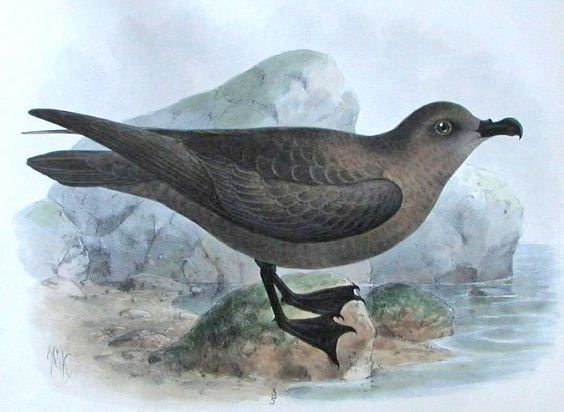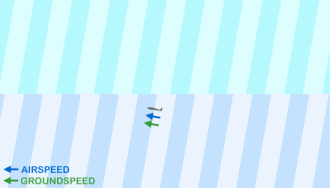|
Albatross
Albatrosses, of the biological family Diomedeidae, are large seabirds related to the procellariids, storm petrels, and diving petrels in the order Procellariiformes (the tubenoses). They range widely in the Southern Ocean and the North Pacific. They are absent from the North Atlantic, although fossil remains of short-tailed albatross show they lived there up to the Pleistocene, and occasional vagrants are found. Great albatrosses are among the largest of flying birds, with wingspans reaching up to and bodies over in length. The albatrosses are usually regarded as falling into four genera, but disagreement exists over the number of species. Albatrosses are highly efficient in the air, using dynamic soaring and slope soaring to cover great distances with little exertion. They feed on squid, fish, and krill by either scavenging, surface seizing, or diving. Albatrosses are colonial, nesting for the most part on remote oceanic islands, often with several species nesting ... [...More Info...] [...Related Items...] OR: [Wikipedia] [Google] [Baidu] |
Procellariiformes
Procellariiformes is an order (biology), order of seabirds that comprises four family (biology), families: the albatrosses, the Procellariidae, petrels and shearwaters, and two families of storm petrels. Formerly called Tubinares and still called tubenoses in English, procellariiforms are often referred to collectively as the petrels, a term that has been applied to all members of the order,Warham, J. (1996). ''The Behaviour, Population, Biology and Physiology of the Petrels''. London: Academic Press, or more commonly all the families except the albatrosses.Brooke, 2004. They are almost exclusively pelagic (feeding in the open ocean), and have a cosmopolitan distribution across the world's oceans, with the highest species diversity, diversity being around New Zealand. Procellariiforms are seabird colony, colonial, mostly nesting on remote, predator-free islands. The larger species nest on the surface, while most smaller species nest in natural cavities and burrows. They exhibit ... [...More Info...] [...Related Items...] OR: [Wikipedia] [Google] [Baidu] |
Short-tailed Albatross
The short-tailed albatross or Steller's albatross (''Phoebastria albatrus'') is a large rare seabird from the North Pacific. Although related to the other North Pacific albatrosses, it also exhibits behavioural and morphological links to the albatrosses of the Southern Ocean. It was described by the Germany, German Natural history, naturalist Peter Simon Pallas from skins collected by Georg Wilhelm Steller (after whom its other common name is derived). Once common, it was brought to the edge of extinction by the plume hunting, trade in feathers, but with protection efforts underway since the 1950s, the species is in the process of recovering with an increasing population trend. It is divided into two distinct subpopulations, one of which breeds on Tori-shima (Izu Islands), Tori-shima in the Izu islands south of Japan, and the other primarily on the Senkaku Islands in the East China Sea. Description The short-tailed albatross is a medium-sized albatross, with a wingspan of ,Dunn ... [...More Info...] [...Related Items...] OR: [Wikipedia] [Google] [Baidu] |
Great Albatross
The great albatrosses are seabirds in the genus ''Diomedea'' in the albatross family (biology), family. The genus ''Diomedea'' formerly included all albatrosses except the sooty albatrosses, but in 1996 the genus was split, with the mollymawks and the North Pacific albatrosses both being elevated to separate genera. The great albatrosses themselves form two species complexes, the wandering and Amsterdam albatrosses, and the royal albatrosses. The splitting of the great albatrosses into six or seven species has been accepted by most, though not all, authorities. Description The snowy albatross and the southern royal albatross are the largest of the albatrosses and are among the largest of bird flight, flying birds. They have the largest wingspans of any bird, being up to from tip to tip, although the average is a little over . Large adult males of these two species may exceed in weight, as heavy as a large swan. The great albatrosses are predominantly white in plumage as adu ... [...More Info...] [...Related Items...] OR: [Wikipedia] [Google] [Baidu] |
North Pacific Albatross
The North Pacific albatrosses are large seabirds from the genus ''Phoebastria'' in the albatross family. They are the most tropical of the albatrosses, with two species (the Laysan and black-footed albatrosses) nesting in the Northwestern Hawaiian Islands, one on sub-tropical islands south of Japan (the short-tailed albatross), and one nesting on the equator (the waved albatross). Taxonomy Their taxonomy is very confusing, as with all albatrosses. It is widely accepted now, based on molecular evidence and the fossil record, that they are a distinct genus from '' Diomedea'' in which formerly most "white" albatrosses were placed but which is now restricted to the "great" albatrosses. They share certain identifying features. First, they have nasal passages that attach to the upper bill called naricorns. Although the nostrils on the albatross are on the sides of the bill. The bills of Procellariiformes are also unique in that they are split into between seven and nine horny plates. ... [...More Info...] [...Related Items...] OR: [Wikipedia] [Google] [Baidu] |
Phoebetria
The sooty albatrosses are small albatrosses from the genus ''Phoebetria''. There are two species, the sooty albatross, ''Phoebetria fusca'', and the light-mantled albatross, ''Phoebetria palpebrata''. Systematics The sooties have long been considered distinct from the rest of the other albatrosses, and have retained their generic status through the many revisions of the family over the last 150 years. They have traditionally been thought of as primitive, sharing some morphological features with the other petrel families. However, molecular work examining the mitochondrial DNA has shown that the taxon is related to the mollymawks, and that the two taxa are distinct from the great albatrosses and the North Pacific albatrosses. Description Both have distinctive blackish plumage over the head, wings and bellies. The sooty albatross has a dark back and mantle as well, whereas the light-mantled has an ashy-grey mantle, back and rump. The two species can also be told apa ... [...More Info...] [...Related Items...] OR: [Wikipedia] [Google] [Baidu] |
Seabird
Seabirds (also known as marine birds) are birds that are adaptation, adapted to life within the marine ecosystem, marine environment. While seabirds vary greatly in lifestyle, behaviour and physiology, they often exhibit striking convergent evolution, as the same environmental problems and feeding ecological niche, niches have resulted in similar adaptations. The first seabirds evolved in the Cretaceous geological period, period, while modern seabird families emerged in the Paleogene. Seabirds generally live longer, Reproduction, breed later and have fewer young than other birds, but they invest a great deal of time in their young. Most species nest in Bird colony, colonies, varying in size from a few dozen birds to millions. Many species are famous for undertaking long annual bird migration, migrations, crossing the equator or circumnavigating the Earth in some cases. They feed both at the ocean's surface and below it, and even on each other. Seabirds can be highly pelagic, ... [...More Info...] [...Related Items...] OR: [Wikipedia] [Google] [Baidu] |
Thalassarche
The mollymawks are a group of medium-sized albatrosses that form the genus ''Thalassarche''. The name has sometimes been used for the genus ''Phoebetria'' as well, but these are usually called sooty albatrosses. They are restricted to the Southern Hemisphere, where they are the most common of the albatrosses. They were long considered to be in the same genus as the great albatrosses, ''Diomedea'', but a study of their mitochondrial DNA showed that they are a monophyletic taxon related to the sooty albatrosses, and they were placed in their own genus. Taxonomy The genus ''Thalassarche'' was introduced in 1853 by the German naturalist Ludwig Reichenbach with the black-browed albatross as the type species. The genus name combines the Ancient Greek meaning "sea" and meaning "power" or "command" (from ', to govern). The word ''mollymawk'', which dates to the late 17th century, comes from the Dutch , which means ''mal'' – foolish and ''mok'' – gull. Another etymology suggests ... [...More Info...] [...Related Items...] OR: [Wikipedia] [Google] [Baidu] |
Midway Atoll
Midway Atoll (colloquialism, colloquial: Midway Islands; ; ) is a atoll in the North Pacific Ocean. Midway Atoll is an insular area of the United States and is an Insular area#Unorganized unincorporated territories, unorganized and unincorporated territory. The largest island is Sand Island, which has housing and an airstrip. Immediately east of Sand Island, across the narrow Brooks Channel, is Eastern Island, which is uninhabited and no longer has any facilities. Forming a rough, incomplete circle around the two main islands and creating Midway Lagoon is Spit Island, a narrow reef. Roughly equidistant between North America and Asia, Midway is the only island in the Hawaiian Islands, Hawaiian Archipelago that is not part of the state of Hawaii. Unlike the other Hawaiian islands, Midway observes Samoa Time Zone, Samoa Time (UTC−11:00, i.e., eleven hours behind Coordinated Universal Time), which is one hour behind the time in the Hawaii–Aleutian Time Zone used in Hawaii. Fo ... [...More Info...] [...Related Items...] OR: [Wikipedia] [Google] [Baidu] |
Procellariidae
The family (biology), family Procellariidae is a group of seabirds that comprises the fulmarine petrels, the gadfly petrels, the diving petrels, the prion (bird), prions, and the shearwaters. This family is part of the bird order (biology), order Procellariiformes (or tubenoses), which also includes the albatrosses and the storm petrels. The procellariids are the most numerous family of tubenoses, and the most diverse. They range in size from the giant petrels with a wingspan of around , that are almost as large as the albatrosses, to the diving petrels with a wingspan of around that are similar in size to the little auks or dovekies in the family Alcidae. Male and female birds are identical in appearance. The plumage color is generally dull, with blacks, whites, browns and grays. The birds feed on fish, squid and crustacea, with many also taking Discards, fisheries discards and carrion. Whilst agile swimmers and excellent in water, petrels have weak legs and can only shuffle o ... [...More Info...] [...Related Items...] OR: [Wikipedia] [Google] [Baidu] |
Southern Ocean
The Southern Ocean, also known as the Antarctic Ocean, comprises the southernmost waters of the world ocean, generally taken to be south of 60th parallel south, 60° S latitude and encircling Antarctica. With a size of , it is the second-smallest of the five principal oceanic divisions, smaller than the Pacific Ocean, Pacific, Atlantic Ocean, Atlantic and Indian Ocean, Indian oceans, and larger than the Arctic Ocean. The maximum depth of the Southern Ocean, using the definition that it lies south of 60th parallel, was surveyed by the Five Deeps Expedition in early February 2019. The expedition's multibeam sonar team identified the deepest point at 60° 28' 46"S, 025° 32' 32"W, with a depth of . The expedition leader and chief submersible pilot Victor Vescovo, has proposed naming this deepest point the "Factorian Deep", based on the name of the crewed submersible ''DSV Limiting Factor'', in which he successfully visited the bottom for the first time on February 3, 2019 ... [...More Info...] [...Related Items...] OR: [Wikipedia] [Google] [Baidu] |
Dynamic Soaring
Dynamic soaring is a flying technique used to gain energy by repeatedly crossing the boundary between air masses of different velocity. Such zones of wind gradient are generally found close to obstacles and close to the surface, so the technique is mainly of use to birds and operators of radio-controlled gliders, but glider pilots are sometimes able to soar dynamically in meteorological wind shears at higher altitudes. Dynamic soaring is sometimes confused with slope soaring which is a technique for achieving elevation. Basic mechanism While different flight patterns can be employed in dynamic soaring, the simplest is a closed loop across the shear layer between two airmasses in relative movement, e.g. stationary air in a valley, and a layer of wind above the valley. The gain in speed can be explained in terms of airspeed and groundspeed: * As the glider begins the loop, say in a stationary airmass, groundspeed and airspeed are the same. * The glider enters the moving airmass n ... [...More Info...] [...Related Items...] OR: [Wikipedia] [Google] [Baidu] |





